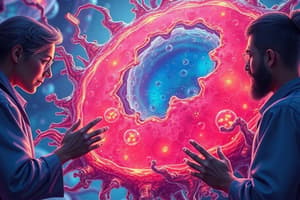Podcast
Questions and Answers
Which scientist is credited with the first use of the term 'cells' in scientific observation?
Which scientist is credited with the first use of the term 'cells' in scientific observation?
- Robert Hooke (correct)
- Robert Brown
- Louis Pasteur
- Anthonie van Leeuwenhoek
Which statement best describes Rudolf Virchow's contribution to cell theory?
Which statement best describes Rudolf Virchow's contribution to cell theory?
- Cells can arise from non-cellular materials.
- Cells arise only by division of existing cells. (correct)
- All cells share the same structure.
- Cells are dynamic entities that can spontaneously form.
What key observation did Robert Brown make regarding cell components?
What key observation did Robert Brown make regarding cell components?
- The existence of a cell wall in all cells.
- The presence of chloroplasts in plant cells.
- The random movement of particles suspended in water. (correct)
- The formation of two distinct types of cells.
What was Anthonie van Leeuwenhoek's primary method for studying cells?
What was Anthonie van Leeuwenhoek's primary method for studying cells?
Which of the following features is common to both plant and animal cells?
Which of the following features is common to both plant and animal cells?
What significant conclusion can be drawn from Louis Pasteur's broth experiment?
What significant conclusion can be drawn from Louis Pasteur's broth experiment?
Which statement accurately reflects the contributions of Matthias Schleiden and Theodor Schwann to cell biology?
Which statement accurately reflects the contributions of Matthias Schleiden and Theodor Schwann to cell biology?
What primary characteristic differentiates a plant cell from an animal cell?
What primary characteristic differentiates a plant cell from an animal cell?
Which of the following scientists contributed to the understanding of microbial life in relation to air?
Which of the following scientists contributed to the understanding of microbial life in relation to air?
Which aspect of early microscopy significantly advanced the formation of cell theory?
Which aspect of early microscopy significantly advanced the formation of cell theory?
Flashcards are hidden until you start studying
Study Notes
The Origins of Cell Theory
- Development of cell theory occurred in 19th century Western Europe, driven by advances in microscopy and biochemistry.
- Robert Hooke (1662): Invented a compound microscope; first to observe and name "cells" from cork.
- Anthonie van Leeuwenhoek (1680): Amateur lens maker; achieved magnifications of x240, discovered various cell types, including blood cells and bacteria.
- Robert Brown (1831): Scottish botanist; identified the cell nucleus and described Brownian movement, showing random particle motion in liquids.
- Matthias Schleiden (1838) and Theodor Schwann (1839): Concluded that organisms are made of cells, establishing cells as fundamental units of life.
- Rudolf Virchow (1856): Proposed cells arise only through division of existing cells, reinforcing the idea of cell lineage.
- Louis Pasteur (1862): Disproved spontaneous generation; demonstrated that bacteria in broth originate from air contamination.
Introducing Animal and Plant Cells
-
No "typical" cell exists; substantial diversity in cell types, yet many share common features.
-
Basic structure of a cell includes a fluid-filled sac, membrane, and nucleus.
-
Plant Cells (e.g., Canadian Pondweed - Elodea):
- Contains a large permanent vacuole and a cellulose cell wall.
- Features chloroplasts with starch grains for photosynthesis.
- Connections exist between cells via pits in the cell wall (middle lamella).
-
Animal Cells (e.g., Human Cheek Cell):
- Composed of cytoplasm, plasma membrane, and nucleus.
- Contains secretory granules and temporary vacuoles.
- Centrioles present, playing a role in cell division.
Pasteur's Experiment
- Demonstrated methods of sterilization and contamination.
- Broth sterilized and tested in two scenarios:
- Exposed to air became contaminated with bacteria.
- Sealed in a swan-necked flask remained uncontaminated, proving necessity of airborne spores for microbial growth.
Studying That Suits You
Use AI to generate personalized quizzes and flashcards to suit your learning preferences.




